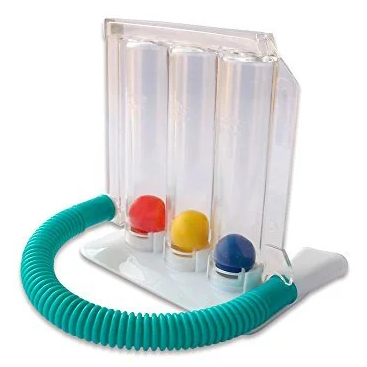

Article-13
IMPORTANCE OF INCENTIVE SPIROMETRY BEFORE AND AFTER CARDIAC SURGERY
Dr. Pratima Parmar (MPT cardiopulmonary)
Olympus hospital, Rajkot
Postoperative pulmonary complications (PPCs) often occur after cardiac operations and are a leading cause of morbidity, inhibit oxygenation, and increase hospital length of stay and mortality. So the effect of preoperative incentive spirometry to prevent postoperative pulmonary complications, improve postoperative oxygenation, and decrease hospital stay following coronary artery bypass graft (CABG) surgery patients.

Preoperative incentive spirometry for two days along with the exercise of deep breathing, encouraged coughing, and early ambulation following CABG are in connection with prevention and decreased incidence of atelectasis, hospital stay, mechanical ventilation duration and improved postoperative oxygenation with better pain control.
Incentive spirometry, also referred to as sustained maximal inspiration, is accomplished by using a device that provides feedback when the patient inhales at a predetermined flow or volume and sustains the inflation for at least 5 seconds. The patient is instructed to hold the spirometer in an upright position, exhale normally, and then place the lips tightly around the mouthpiece. The next step is a slow inhalation to raise the ball (flow-oriented) or the piston/plate (volume-oriented) in the chamber to the set target.
At maximum inhalation, the mouthpiece is removed, followed by a breath-hold and normal exhalation. Instruction of parents, guardians, and other health caregivers in the technique of incentive spirometry may help to facilitate the patient's appropriate use of the technique and assist with encouraging adherence to therapy.
Why do you use incentive spirometer before surgery ?
An incentive spirometer helps clear anesthesia from your lungs. Loosen mucus from your lungs. Deep exhalations help prevent mucus and fluids from building up in your lungs. Help prevent lung complications. Performing respiratory exercises will help you prevent respiratory system complications. Deep breathing, coughing, and incentive spirometer exercises may speed your recovery and lower your risk of lung problems, such as pneumonia.
The risk and severity of complications can be reduced by the use of therapeutic maneuvers that increase lung volume. Incentive spirometry has been routinely considered a part of the perioperative respiratory therapy strategies to prevent or treat complications. Incentive spirometry is designed to mimic natural sighing or yawning by encouraging the patient to take long, slow, deep breaths. This decreases pleural pressure, promoting increased lung expansion and better gas exchange. When the procedure is repeated on a regular basis, atelectasis may be prevented or reversed.
Is an incentive spirometer good after heart Surgery ?
During many open heart surgery procedures, your healthcare provider will hook you up to a heart-lung bypass machine. A heart-lung bypass machine connects to your heart. It temporarily takes over for your heart and lungs, so blood still circulates around your body, but it moves away from your heart. It also deflates your lungs.
When there is no air in your lungs, they may create mucus. An incentive spirometer helps remove the mucus and other fluids from your lungs as you recover from the procedure. An incentive spirometer helps remove the mucus and other fluids from your lungs.
As you recover from the procedure. An incentive spirometer is a medical device that helps your lungs recover after surgery or a lung
illness.
At the hospital: You will need to use the incentive spirometer 10 times every hour you are awake after surgery.
At home: You will need to use the incentive spirometer 10 times every two hours for your first seven days at home.